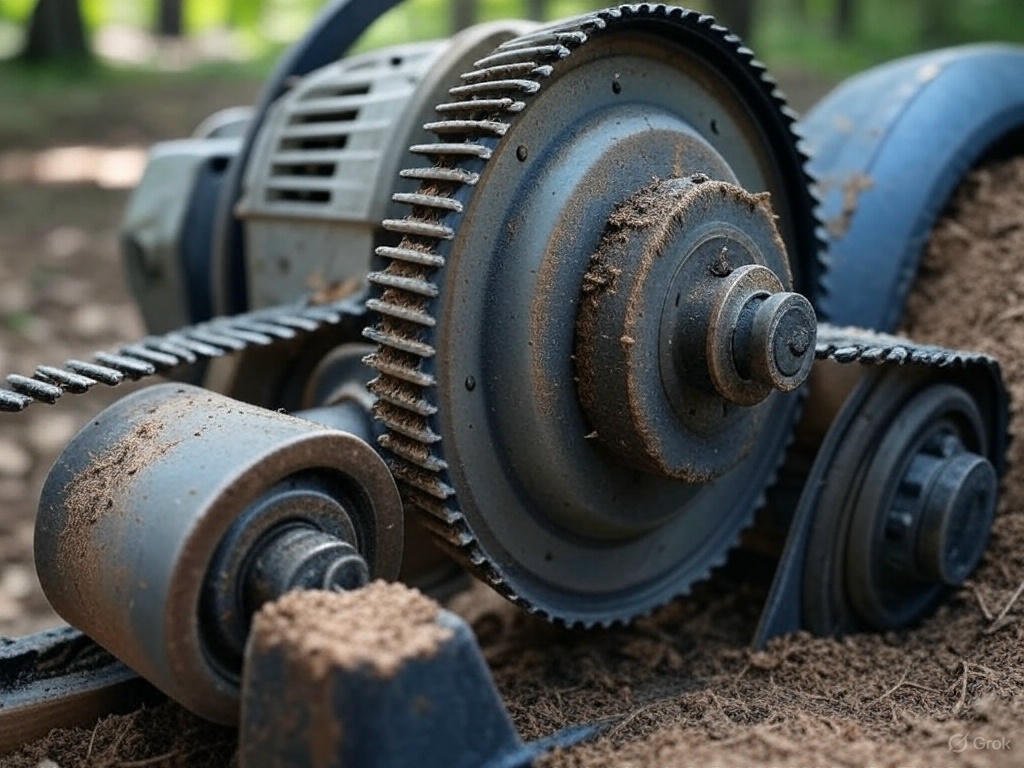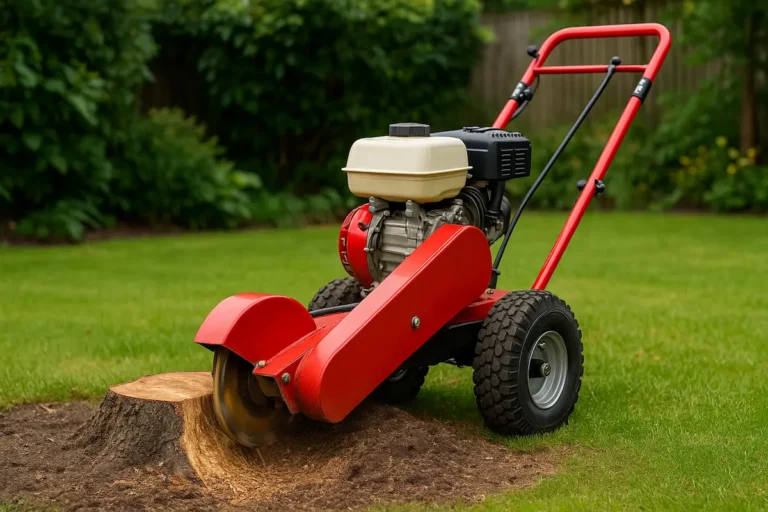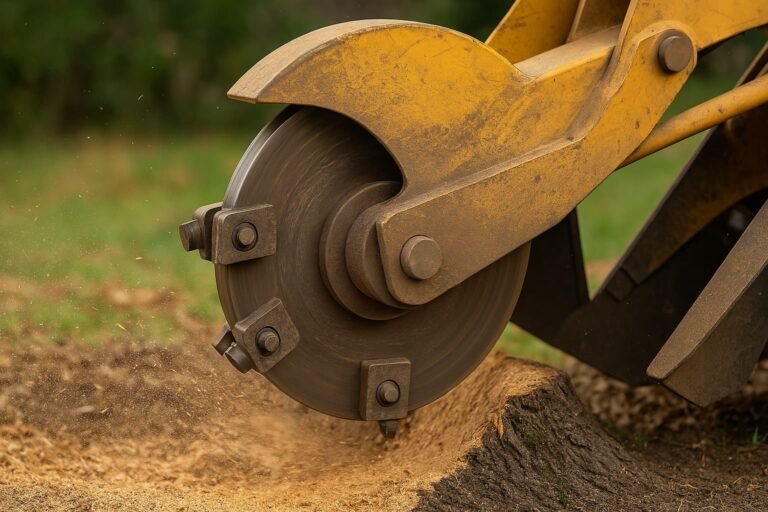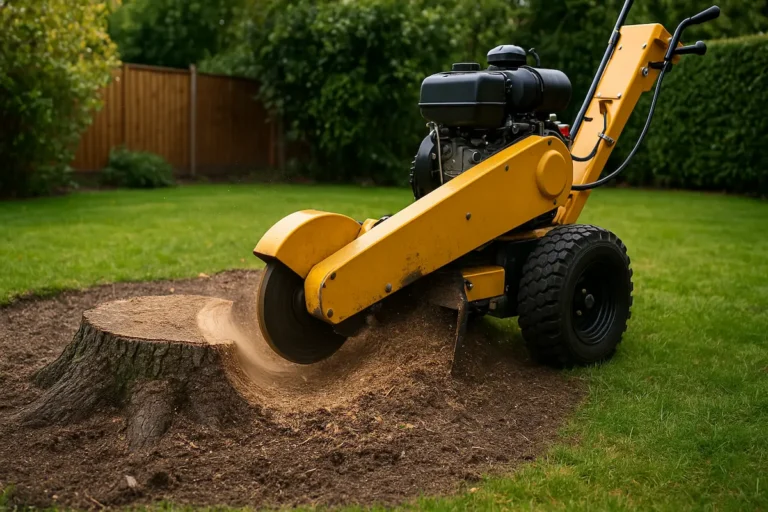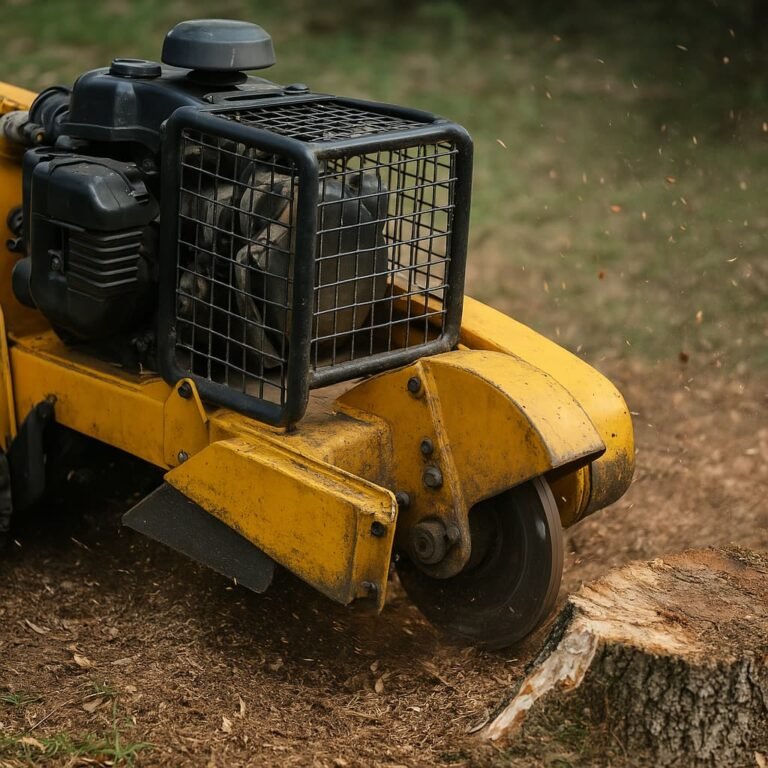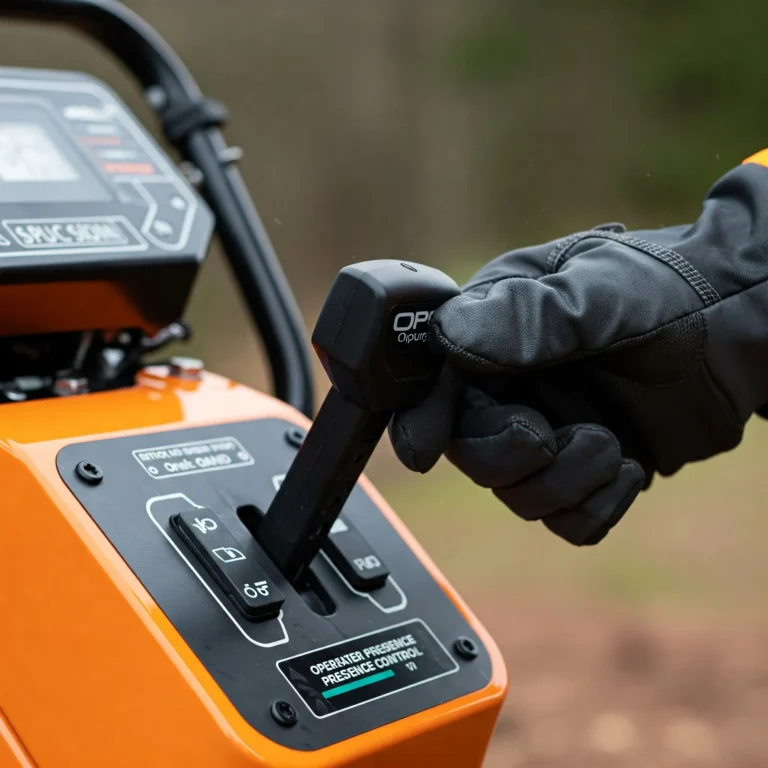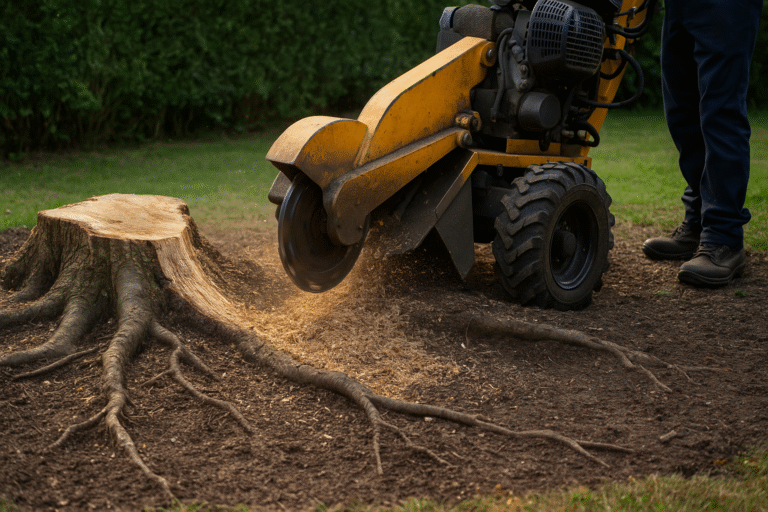Polychain Belts: The Powerhouse Drive Behind Your Stump Grinder Hire
Polychain belts are super strong belts used in many stump grinders.
They move power from the engine to the grinder’s cutting wheel.
Think of them as a key part that makes the grinder work powerfully.
Let’s learn why they are essential for grinding tree stumps effectively.
Polychain vs. V-Belt: Stump Grinder Performance Comparison
Key Takeaways from the Chart
- Performance Dominance: Polychain belts significantly outperform V-belts in Power Grip, Torque Handling, and Efficiency due to their non-slip toothed design.
- Durability & Longevity: Polychain belts offer superior Durability and a longer Lifespan in demanding stump grinding conditions.
- Maintenance Profile: Polychain belts typically require less frequent maintenance (tensioning).
- Setup Sensitivity: Polychain belts have lower tolerance for misalignment (Alignment Tolerance score is low, meaning setup is more critical) compared to V-belts.
- Cost Factor: V-belts’ main advantage is their lower Initial Cost (higher affordability score).
- Overall: For high-performance grinding where reliability and reduced downtime are key, Polychain belts are often superior despite higher cost and stricter setup.
What Exactly is a Polychain Belt in Stump Grinding?
A Polychain belt helps turn the stump grinder’s cutting wheel.
It connects the engine to the part that grinds the wood.
It looks like a bike chain but is made of different stuff.
These belts usually use strong polyurethane, like rigid plastic.
They also have super strong carbon fibre cords inside them.
These cords strengthen the belt and stop it from stretching too much.
The belt has teeth on the inside surface.
These teeth fit perfectly into grooves on special wheels called sprockets.
This grip means the belt does not slip, even when working hard.
This is different from older V-belts, which are smooth and can slip.
Gates Poly Chain® GT® Carbon™ is a prevalent type you might see.
They are popular because they work well in tough machines like stump grinders.
Why Modern Stump Grinders Rely on Polychain Technology
Stump grinders need vast amounts of power to chew through hardwood.
Polychain belts are great at handling this massive power, called torque.
They transfer the engine’s energy to the cutting wheel very well.
Because the teeth lock into the sprockets, there is almost no slipping.
This means the cutting wheel gets consistent and always has strong power.
Consistent power helps the grinder work faster and smoother.
V-belts can slip when the grinder hits a tricky bit of wood.
Slipping wastes energy and makes the grinding less effective.
Polychain belts avoid this problem with their toothed design.
This technology also allows machine makers to build powerful grinders that are not too bulky.
The belts can handle lots of power, even if they are pretty narrow.
So, Polychain belts help grinders be robust, reliable, and efficient.
Unpacking the Advantages: Benefits of Polychain Belts for Grinding
These belts offer some big plus points for stump grinding work.
Delivering Unmatched Torque and Power
Polychain belts are champions at moving power.
They have what is called high power density.
This means they can handle a lot of force for their size.
They move power much better than older V-belt systems.
The most significant advantage is minimal slipping.
The belt holds firm when the cutting wheel bites into thick stump wood.
It keeps delivering the engine’s full force to the cutter.
This leads to quicker grinding and less strain on the engine.
“The power transfer is just incredible. You feel the difference immediately compared to the old V-belt grinders.” – Experienced Arborist Comment Summary.
Boosting Durability for Tough Conditions
Stump grinding is a dirty, rough job.
There is dust, wood chips, dirt, and sometimes leaking fluids.
Polychain belts are built tough for these environments.
The polyurethane material resists damage from rubbing and scrapes.
It also handles chemicals like oil or hydraulic fluid better than rubber V-belts.
Water and dampness do not affect them as much, either.
The carbon fibre cords inside are powerful.
They resist stretching, even after many hours of hard work.
This means the belt keeps its shape and tension for longer.
How long do they last? It varies, but reports suggest impressive lifespans.
- Common Lifespan: Many users on forums and video comments report getting 1000 to over 2000 hours of use from one Polychain belt.
- Comparison: This is often much longer than V-belts would last, doing the same tough job.
Case Study Snippet (Based on forum posts): A tree company switched to grinders using Polychain belts. They noticed they spent much less time stopping for belt changes. This saved them time and money, even though the Polychain belt initially cost more.
Reducing Maintenance Downtime
Nobody likes it when machines break down.
Polychain belts generally need less looking after than other systems.
They do not need oiling like a metal roller chain does.
They also stretch very little over their life.
This means you do not need to adjust the belt tension as often as V-belts.
V-belts need to be quite tight to grip properly.
This high tightness can put extra stress on machine parts called bearings.
Polychain belts work well without needing such high tension.
This can help the bearings last longer, too.
Less adjustment means the grinder is working more and stopped less.
Improving Operational Efficiency
Because Polychain belts do not slip much, less energy is wasted.
More of the engine’s power goes directly into grinding the stump.
This can mean the machine works slightly more efficiently.
Some people find it to use less fuel.
The main thing is the consistent performance they provide.
Considering the Drawbacks: What to Be Aware Of
Polychain belts are great, but they have some points to remember.
Understanding the Higher Initial Investment
These advanced belts cost more money upfront.
A replacement Polychain belt for a grinder can be expensive.
It might cost several hundred pounds.
The special toothed sprockets they run on also cost more than V-belt wheels (sheaves).
A set of V-belts for the same grinder might cost much less.
- Cost Example (Illustrative): A Polychain belt could cost £ 300-£600+, Compared to under £100 for V-belts. (Prices vary a lot!)
You must weigh this higher cost against the longer life and less downtime.
Recognising Sensitivity to Misalignment
This is important for Polychain belts.
The two sprockets (the drive and driven ones) must line up perfectly straight.
The belts will wear out quickly if they are slightly out of line.
The edges of the belt will get chewed up quickly.
Misalignment can cause the belt to fail much sooner than it should.
Checking and setting the Alignment needs care.
“Alignment is key! If it’s off, you’ll buy a new belt much sooner than you want.” – Forum User Tip Summary.
Ensuring Correct Belt Tension is Vital
While they need less adjusting, the initial tension must be spot on.
If the belt is too tight, it stresses the belt and the machine’s bearings.
This can lead to early failure of the belt or bearings.
If the belt is too loose, the teeth can jump out of the sprocket grooves under load.
This is called tooth jumping or ratcheting.
It can badly damage the belt teeth, and the sprockets very quickly.
Manufacturers give specific instructions on how to set the tension.
Often, special tools are recommended for getting it just right.
One standard tool is a sonic tension meter, which listens to the belt’s vibration frequency.
Noting Potential for Sudden Failure
When a Polychain belt does fail, it often happens suddenly.
It might snap completely without much warning.
This differs from a V-belt, which usually starts slipping more and more as it wears out.
A sudden belt break can sometimes cause other damage if parts fly off.
Regular checks help spot problems before they lead to a sudden break.
Essential Maintenance: Keeping Your Polychain Belt Performing
Looking after your Polychain belt properly helps it last a long time.
It also keeps your stump grinder running reliably.
Performing Regular Visual Inspections
Check the belt often, perhaps every day before starting work.
Look closely at the belt surface and edges.
- Check for Cracks: Look for any cracks on the back (smooth side) of the belt.
- Check Teeth: Inspect the teeth for damage. Are there any missing chunks (chunking)? Are they looking worn down?
- Check Edges: Look at the sides of the belt. Are they frayed or worn? This could mean the Alignment is off.
- Check for Debris: Ensure no stones, wood chips, or dirt are stuck in the belt teeth or sprocket grooves.
- Check Sprockets: While checking the belt, look at the sprocket teeth, too. Are they worn into a hook shape? Are they damaged? Running a new belt on worn sprockets will quickly ruin the new belt.
ACTION: Do a quick visual check daily. Clean out any debris you find.
Mastering Correct Belt Tensioning Techniques
Always follow the stump grinder maker’s instructions for tension.
These are usually found in the machine’s user manual.
They will tell you how tight the belt should be.
There are a few ways this is measured:
- Deflection: Pushing the belt in the middle with a certain force and measuring how much it moves. The manual states the force and the correct movement distance.
- Frequency/Sonic Meter: Using a special tool (like the Gates Sonic Tension Meter) that measures how fast the belt vibrates when you ‘pluck’ it. The manual gives the correct frequency reading (in Hertz).
Many grinders have a bolt or screw system to adjust the tension easily.
ACTION: Find the tension specs in your grinder manual. Use the recommended method. If unsure, ask a qualified mechanic.
Verifying Proper Sprocket Alignment
Alignment checks are super necessary, especially when fitting a new belt.
Check it now and then as part of regular maintenance, too.
The belt will not last long if the sprockets are not lined up.
- Tools: Professionals often use laser alignment tools. These shine laser lines to show if the sprockets are perfectly parallel and in line.
- Simple Check: You can do a basic check using a reliable straight edge (like a metal ruler or level). Place it across the faces of both sprockets. It should touch evenly across both faces if they are aligned. Check this in several positions around the sprockets.
ACTION: Check Alignment carefully when replacing a belt. If possible, use a laser tool for the best results. Even a straight-edge check is better than nothing.
Replacing a Worn or Damaged Polychain Belt
Eventually, even the best belt will wear out or get damaged.
Replacing it involves a few key steps.
Always follow your grinder’s service manual for specific instructions.
General steps usually include:
- Safety First: Make sure the grinder engine is off and cannot possibly start. Disconnect the battery if needed.
- Access: Remove any safety guards covering the belt drive system.
- Release Tension: Loosen the belt tension using the adjuster mechanism.
- Remove Old Belt: Carefully slide the old belt off the sprockets. Never force or pry it off with tools like screwdrivers, as this can damage the sprockets or the new belt.
- Inspect Sprockets: This is the perfect time to check the sprockets closely for wear or damage. Replace them if they look worn. Putting a new belt on worn sprockets is a waste of money!
- Install New Belt: Carefully slide the new belt onto the sprockets. Make sure the teeth mesh correctly in the grooves.
- Check Alignment: Verify the sprocket alignment is still correct. Adjust if needed.
- Set Tension: Tension the new belt according to the manufacturer’s specifications using the correct method (deflection or sonic meter). Double-check the tension after a brief run-in period if the manual suggests it.
- Replace Guards: Put all safety guards back in place securely.
ACTION: Always use the right belt specified for your grinder model. Refer to the service manual. If unsure, get professional help.
Troubleshooting Common Polychain Belt Issues on Grinders
Sometimes, things might not seem right with the belt drive.
Here are some common issues and what they might mean:
Common Problems Summary Box
- Problem:Unusual Noise (Whining/Howling)
- Possible Causes: Belt tension is too high, and there are worn bearings in the engine or cutter wheel shaft.
- Problem:Unusual Noise (Clicking/Ratcheting)
- Possible Causes: Belt tension is too low (teeth jumping); the debris is stuck in sprocket grooves; belt or sprocket teeth are damaged.
- Problem:Belt Edge Wear (Fraying/Grooving)
- Possible Causes: Sprocket misalignment (most likely cause).
- Problem:Cracks on Belt Back
- Possible Causes: Excessive heat; Belt nearing the end of life; Too much bending around small sprockets (less common on grinders).
- Problem:Teeth Worn Down or Missing (Chunking)
- Possible Causes: Incorrect tension (often too low); Shock loads (hitting rocks); Debris getting between belt and sprocket; Worn sprockets damaging the belt.
- Problem:Belt Breaks Suddenly
- Possible Causes: Shock load (hitting something solid); debris ingestion causing a jam; pre-existing damage that was missed; belt simply reaching its end of life.
Stop the machine and investigate safely if you notice any of these problems.
Ignoring strange noises or wear patterns often leads to bigger, more expensive failures.
Real-World Insights: Lifespan and User Experiences
What do people who use these grinders every day say?
Based on comments found on forums like ArboristSite and under YouTube videos:
- Lifespan: As mentioned, 1000-2000+ hours seem achievable with good care. Some report even more.
- Power Praise: Users frequently praise the direct power feel. Quotes like “This thing rips with the Poly Chain!” are common.
- Maintenance Focus: Experienced users always stress correct tension and Alignment as the secret to long belt life.
- Cost Factor: The high replacement cost is often mentioned. “Broke mine yesterday, that’s £450 I didn’t want to spend.” (Cost is illustrative).
- Failure Modes: Sudden snaps, tooth shearing (breaking off), and delamination (layers separating) are sometimes discussed and often linked to suspected setup errors or hitting hidden objects.
Overall, professionals agree that the benefits outweigh the costs and extra care needed, especially on powerful grinders.
Polychain vs. V-Belts: Why Polychain Wins for High-Performance Grinding
Let’s quickly compare them for stump grinding jobs:
| Feature | Polychain Belt | V-Belt | Winner for Grinding |
|---|---|---|---|
| Power Grip | Excellent (Toothed, No Slip) | Fair (Relies on Friction) | Polychain |
| Torque Handling | Very High | Moderate (Can Slip) | Polychain |
| Durability | High (Resists Wear, Stretch) | Moderate (Affected by Heat, Oil) | Polychain |
| Lifespan | Long (1000-2000+ hrs often) | Shorter (Needs more changes) | Polychain |
| Maintenance | Less Frequent Tensioning | Needs Regular Tensioning | Polychain |
| Alignment Need | Critical | Less Critical (but still good) | V-Belt (easier setup) |
| Initial Cost | High | Low | V-Belt |
| Efficiency | High | Lower (due to slip/friction) | Polychain |
For the demanding job of stump grinding, Polychain belts offer clear performance advantages in power and durability and require less frequent adjustment, making them the preferred choice for most modern, high-performance machines despite their higher cost and need for careful setup.
Why a Well-Maintained Polychain Belt Matters for Your Grinder Hire
When you hire a stump grinder from us, you want it to work hard and reliably.
The Polychain belt is a vital part of making that happen.
We understand how important these belts are.
That is why we focus on keeping them in top condition.
- Reliability: A well-maintained Polychain belt means the grinder is less likely to break down during your hire. You can get your job done without frustrating stops.
- Performance: Correct belt setup ensures the grinder delivers maximum power to the cutting wheel, helping you grind stumps faster.
- Peace of Mind: Knowing the hire company takes care of crucial parts like the drive belt gives you confidence in the equipment.
What you can do:
- If you hear any strange noises (like clicking, grinding, or whining) coming from the belt area while using the grinder, please stop working safely and tell us immediately. This helps prevent bigger problems.
- Do a quick visual check before you start – look for apparent damage or anything stuck around the belt (but don’t remove guards yourself).
We ensure the Alignment and tension are set correctly before the machine goes out.
Hiring a machine with a properly cared-for Polychain system helps ensure you have a productive hire period.
Key Takeaways: Maximising Polychain Belt Performance
To get the most from a Polychain belt on a stump grinder:
- Remember, they deliver excellent power and last long if cared for.
- Regular checks are essential – look for damage, wear, and debris.
- Correct Alignment is crucial – it prevents rapid wear.
- Correct tension is vital – not too tight, not too loose.
- Always use the right belt and follow the grinder manual.
- Check the sprockets when changing the belt, and replace them if worn.
Proper care leads to reliable performance and longer belt life.
Hire Reliable Grinding Power: Choose Our Well-Maintained Machines
We know that reliable equipment makes your job easier.
Our stump grinders feature strong Polychain drive systems.
We are committed to maintaining these systems carefully.
This means checking belts, tension, and Alignment regularly.
Choose us for dependable stump grinder hire.
You get powerful machines ready to tackle your stump problems.
Ready to grind? Check out our range of stump grinders available for hire today!

